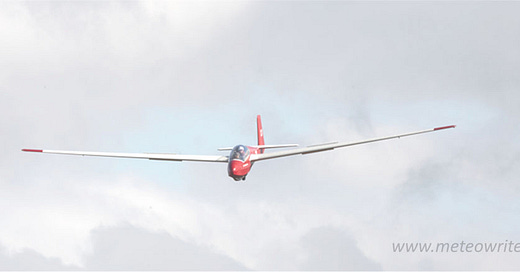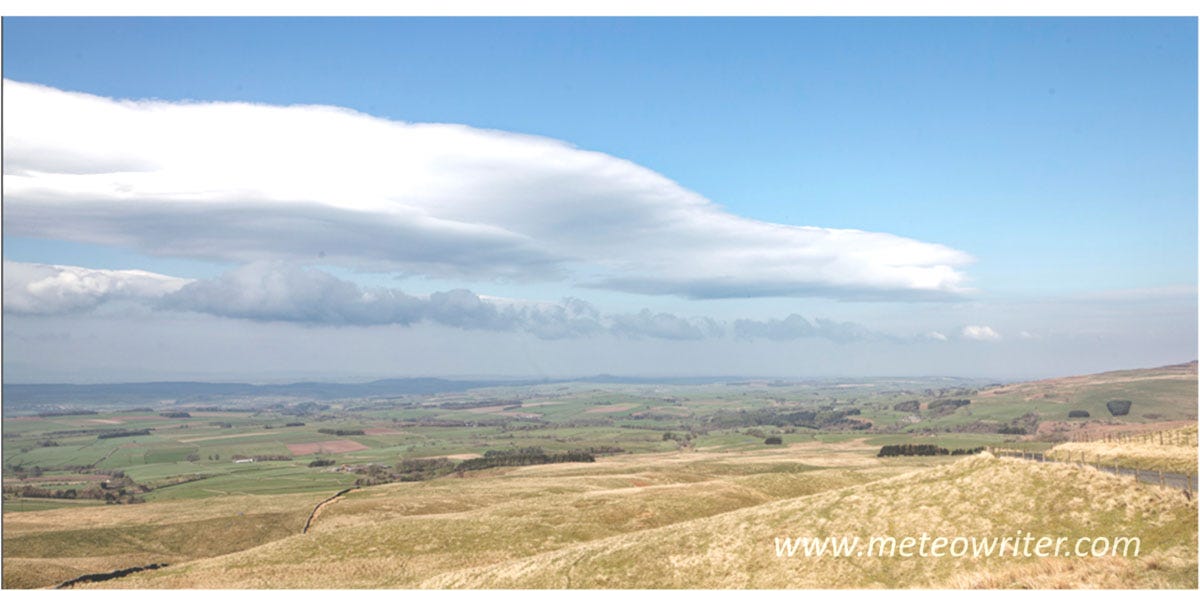Last week I spent some time floating above the Shropshire countryside in one of the more unusual ways to spend a weekend.
This was as part of a taster gliding session with the Midland Gliding Club near Shrewsbury, whose base is near the top of a spectacular six mile long west-facing ridge called the Long Mynd.
An ASK 13 training glider landing during the visit, built by German sailplane manufacturer Schleicher and widely known as a K13. The club also trains using the higher performance fiberglass K21
The club is one of the oldest in the UK and in the early days helped to pioneer the bungee launching of gliders. This typically requires a team of eight to pull tension on two bungee cords and five to hold back the glider until launch. However, winch launching soon took over in which the glider is pulled aloft by cable with an initial acceleration that wouldn’t be out of place in a sports car.
Gliding is the nearest thing you can get to flying like a bird. Powered only by the elements this is one of the greenest air sports. From the website of the Midland Gliding Club (www.midlandgliding.club/)
In addition to the hills and distant mountains, our lofty platform gave views of fluffy cumulus clouds developing in the sunshine plus a hint of wave cloud further upwind. Along with slope lift, this meant lots of rising air around and, on better days, pilots from the club have flown distances of more than 500km and reached heights of more than 18,000 feet using a mix of these types of lift.
Gliders actually make quite good observational platforms and in the early days played a key role in airborne experiments, including for one of my other interests: the Helm wind. This occurs downwind of a long ridge in the north Pennines and – although less exotic sounding than the Mistral of southern France or the Santa Ana winds of the USA – is the UK’s only named wind. When it blows, you can hear its roar in the valley and there are many accounts of damage to farm buildings and other property.
The Helm occurs under certain conditions of wind speed, wind direction and atmospheric stability, causing air to speed up over the ridge then race down the downwind (leeward) side, before rising in the valley beyond as a standing wave. On the best days a spectacular cigar shaped cloud hovers three to four miles out into the valley in an otherwise blue sky, rotating gently in the wind. This is called the Helm Bar and can last for several hours and be up to twenty miles long.
In the early days, several hair-raising glider flights were made to better understand its characteristics. These built on pioneering work by meteorologist Gordon Manley1 in the 1930s, who for about two years made the sometimes arduous weekly trip across the Pennines from his base at Durham University to a hut high in the hills where the Helm is at its strongest. Here he would transcribe three hourly readings of wind speed, air temperature, humidity and pressure to help in his research.
The northern end of an incipient Helm Bar viewed from Hartside Fell
Perhaps the first observational flights in strong Helm conditions were in 1939 on an expedition led by Noel McClean from the Newcastle Gliding Club. During the trip he achieved a British height record of 11,140 feet (3395m) and encountered lift of up to 2400 feet per minute. In comparison, this is approaching three times the height of the UK’s highest peak (Ben Nevis) with a rate of climb comparable to that of an Airbus on take off.
In a later recreation of the flight, Yorkshire Gliding Club pilot Chris Riddell wrote in Sailplane and Gliding magazine that ‘This flight was very turbulent and I found it very unpleasant. I took a winch launch to 800 ft (1,800 ft above sea level) and sank to 600 ft before I found strong lift and climbed away … Turbulence was found at several heights. The worst was felt between 6,000 and 7,000 feet.’
Many years later, a team from the University of Manchester took measurements from both a glider and the ground to help calibrate perhaps the first plausible computer model of the Helm. In addition to the standard instrumentation for airspeed, vertical velocity and altitude, the glider was equipped to record air temperatures, relative humidity and the vertical acceleration. For this weak Helm event, the model and observations showed that several waves formed downwind of the Pennines with a dominant (fundamental) wavelength of about 4km.
A couple of years ago, I was lucky enough to see this for myself under similar conditions, spotting at least two wave bars further downwind. This was later confirmed by one of the forecasting models favoured by glider pilots (RASP), which showed that at least 3-4 wave bars had formed extending across Cumbria and out into the Irish Sea.
Further reading
The Helm Wave, Noel McClean, The Sailplane, 1939
Stromberg IM, Mill CS, Choularton TW, Gallagher MW (1989) A Case Study of Stably Stratified Airflow over the Pennines using an Instrumented Glider. Boundary-Layer Meteorology, 46: 153-168.
Spectacular Britain: a spotter’s guide to the UK’s most amazing natural phenomena, Kevin Sene, Bloomsbury. 2024. For tips on seeing the Helm Bar and further insights into why the Helm wind occurs.
https://www.bloomsbury.com/us/spectacular-britain-9781844866359/
Surfing the mountain waves: from tidal bores to atmospheric waves. Kevin Sene, 2024. For further insights into mountain waves and their similarities with tidal bores.
https://naturestidings.substack.com/p/surfing-the-mountain-waves
1 In later years, perhaps Gordon Manley’s best known achievement was to start the Central England Temperature (CET) series, which dates from 1659 and is the longest instrumental record of air temperatures in the world and invaluable for climate research.







I enjoyed this one! The Helm wave is maybe a bit atypical in that it requires particular contrasting met conditions either side of the ridge and turbulence is probably part and parcel of it. From my hang gliding days I know that the best wave formations occur with a combination of stable high pressure and a temperature inversion, which traps the airflow so that it effectively bounces off the ridge, onto the inversion and back down again. The source of the wave can be many, many miles upwind and the lift it affords is amplified with successive wave sequences, each often marked by a bar cloud where moisture in the rising air condenses. While turbulence is not unknown, once you're flying in the wave itself it's usually very smooth. I once stood at the top of Hartside Pass on an otherwise calm day and was almost blown off my feet as the air raced up across the Durham moors and down into the Eden Valley. Tales of the Helm are legend: supposedly a fireman on the famous Settle-Carlisle railway had the coal blown off his shovel is one such that I recall.